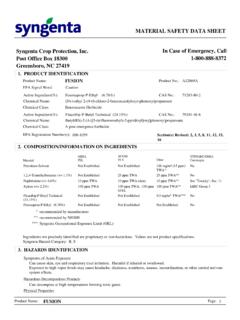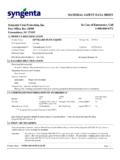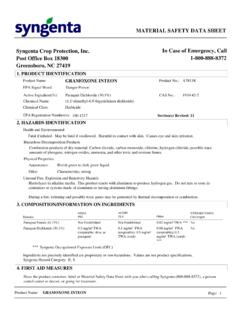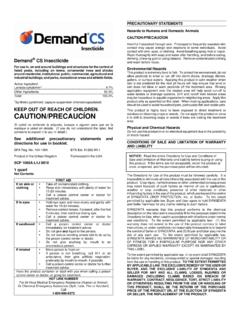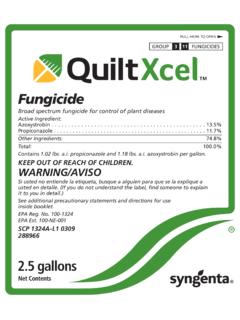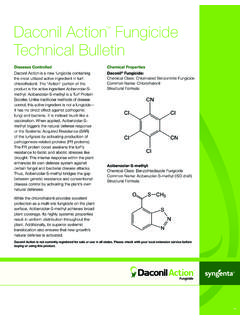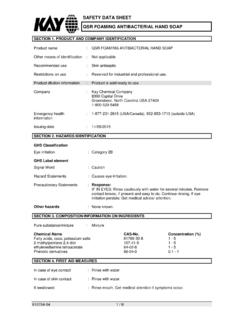Transcription of MATERIAL SAFETY DATA SHEET Syngenta Crop …
1 MATERIAL SAFETY data SHEET 1. PRODUCT IDENTIFICATION 2. COMPOSITION/INFORMATION ON INGREDIENTS 3. HAZARDS IDENTIFICATION 4. FIRST AID MEASURESP roduct No.: A8612 AEPA Signal Word:WarningSymptoms of Acute ExposureCauses eye and skin irritation. Harmful if swallowed or absorbed through the skin. Allergic skin reactions are Decomposition ProductsCan decompose at high temperatures forming toxic PropertiesAppearance:Yellow to red brown liquidOdor:Not determinedUnusual Fire, Explosion and Reactivity HazardsCombustible liquid. Can release vapors that form explosive mixtures at temperatures at or above the flash point. Heavy vapors can flow along surfaces to distant ignition sources and flash a fire, irritating and possibly toxic gases may be generated by thermal decomposition or the product container, label or MATERIAL SAFETY data SHEET with you when calling Syngenta (800-888-8372), a poison Product Name:AGRI-MEK EC MITICIDE/INSECTICIDEEPA Registration Number(s):100-898 Ingredients not precisely identified are proprietary or non-hazardous.
2 Values are not product specifications. Syngenta Hazard Category: C, SSection(s) Revised: 3, 4, 8, 14 Syngenta Crop Protection, Office Box 18300In Case of Emergency, Call1-800-888-8372 Greensboro, NC 27419 CAS No.:65195-56-4 & 65195-55-3 Chemical Name:A mixture of avermectins containing primarily Avermectin B1a and Avermectin B1bChemical Class:Glycoside InsecticideActive Ingredient(%):Abamectin ( )MaterialNTP/IARC/OSHA CarcinogenOtherOSHAPELACGIHTLVNoMineral Oil 5 mg/m (mist)5 mg/m (mist); 10 mg/m (STEL) 5 mg/m (mist); 10 mg/m (STEL) **IARC Group 3 Butylated Hydroxytoluene (BHT) Not Established2 mg/m TWA (inhalable) 10 mg/m TWA **Non-Methylpyrrolidone (<= 30%)Not EstablishedNot Established10 ppm TWA**NoAbamectin ( )Not EstablishedNot mg/m TWA**recommended by NIOSH** Syngenta Occupational Exposure Limit (OEL)**Recommended by AIHA (American Industrial Hygiene Association)Page:1 Product Name: AGRI-MEK EC MITICIDE/INSECTICIDEU pper: % Not ApplicableLower: % Not Applicable 5.
3 FIRE FIGHTING MEASURES contol center or doctor, or going for swallowed: Call Syngenta (800-888-8372), a poison control center or doctor immediately for treatment advice. Do not give any liquid to the person. Do not induce vomiting unless told to do so after calling 800-888-8372 or by a poison control center or doctor. Do not give anything by mouth to an unconscious in eyes: Hold eye open and rinse slowly and gently with water for 15-20 minutes. Remove contact lenses, if present, after 5 minutes, then continue rinsing eye. Call Syngenta (800-888-8372), a poison control center or doctor for treatment on skin or clothing: Take off contaminated clothing.
4 Rinse skin immediately with plenty of water for 15-20 minutes. Call Syngenta (800-888-8372), a poison control center or doctor for treatment inhaled: Move person to fresh air. If person is not breathing, call 911 or an ambulance, then give artificial respiration, preferably mouth-to-mouth if possible. Call Syngenta (800-888-8372), a poison control center or doctor for further treatment to PhysicianMedical Condition Likely to be Aggravated by ExposureNone and ExplosionUnusual Fire, Explosion and Reactivity HazardsCombustible liquid. Can release vapors that form explosive mixtures at temperatures at or above the flash point. Heavy vapors can flow along surfaces to distant ignition sources and flash a fire, irritating and possibly toxic gases may be generated by thermal decomposition or Case of FireUse appropriate extinguishing media for combustibles in the area.
5 Wear full protective clothing and self-contained breathing apparatus. Evacuate nonessential personnel from the area to prevent human exposure to fire, smoke, fumes or products of combustion. Prevent use of contaminated buildings, area, and equipment until decontaminated. Water runoff can cause environmental damage. If water is used to fight fire, dike and collect :Combustible liquid161 F Not AvailableFlash Point (Test Method):Flammable Limits (% in Air):Autoignition Temperature:Ingestion:Eye Contact:Skin Contact:Inhalation: 6. ACCIDENTAL RELEASE MEASURESIn Case of Spill or LeakControl the spill at its source. Contain the spill to prevent from spreading or contaminating soil or from entering sewage and drainage systems or any body of water.
6 Clean up spills immediately, observing precautions outlined in Section 8. Cover entire spill with absorbing MATERIAL and place into compatible disposal container. Scrub area with hard water detergent ( commercial products such as Tide, Joy, Spic and Span). Pick up wash liquid with additional absorbent and place into compatible disposal container. Once all MATERIAL is cleaned up and placed in a disposal container, seal container and arrange for suffering a temporary allergic reaction may respond to treatment with antihistamines or steroid creams and/or systemic for Medical Treatment for Abamectin Acute Toxicity: Early signs of intoxication include dilation of pupils, muscular incoordination, and muscular tremors.
7 Toxicity following accidental ingestion of the technical product can be minimized by vomiting within one-half hour of exposure; rapidly after exposure (< 15 minutes) administer repeatedly medical charcoal in a large quantity of water or ipecac. If toxicity from exposure has progressed to cause severe vomiting, the extent of resultant fluid and electrolyte imbalance should be gauged. Appropriate supportive parental fluid replacement therapy should be given, along with other required supportive measures (such as maintenance of blood pressure levels and proper respiratory functionality) as indicated by clinical signs, symptoms and measurements. In severe cases, observations should continue for at least several days until clinical condition is stable and normal.
8 Since abamectin is believed to enhance GABA activity in animals, it is probably wise to avoid drugs that enhance GABA activity (barbiturates, benzodiazepines, valproic acid) in patients with potentially toxic abamectin :2 Product Name: AGRI-MEK EC MITICIDE/INSECTICIDE 7. HANDLING AND STORAGES tore the MATERIAL in a well-ventilated, secure area out of reach of children and domestic animals. Do not store food, beverages or tobacco products in the storage area. Prevent eating, drinking, tobacco use, and cosmetic application in areas where there is a potential for exposure to the MATERIAL . Wash thoroughly with soap and water after handling. 11. TOXICOLOGICAL INFORMATIONA cute Toxicity/Irritation Studies (Finished Product)Ingestion:Dermal:Inhalation:Eye Contact:Moderately ToxicModerately ToxicPractically Non-ToxicOral (LD50 Rat) : Moderately Irritating (Rabbit)Dermal (LD50 Rabbit) : Inhalation (LC50 Rat) : ~ 300 mg/kg body weight> 1,800 mg/kg body weight mg/l air - 4 hours 9.
9 PHYSICAL AND CHEMICAL PROPERTIESY ellow to red brown liquidNot determined 10. STABILITY AND REACTIVITYS tability:Stable under normal use and storage Polymerization:Will not to Avoid:None decompose at high temperatures forming toxic Point:Boiling Point:Specific Gravity/Density:Not ApplicableNot g/cm (68 - 77 F [20 - 25 C])Appearance:Odor: - (1% in deionized H2O)Solubility in H2 OVapor Pressure 8. EXPOSURE CONTROLS/PERSONAL PROTECTIONP revent eating, drinking, tobacco usage and cosmetic application in areas where there is a potential for exposure to the MATERIAL . Wash thoroughly with soap and water after eye contact is likely, use chemical splash goggles.
10 Facilities storing or utilizing this MATERIAL should be equipped with an eyewash facility and a SAFETY contact is likely, wear chemical-resistant (such as nitrile or butyl) gloves, coveralls, socks and chemical-resistant footwear. For overhead exposure, wear chemical-resistant combination particulate/ organic vapor respirator may be necessary until effective engineering controls are installed to comply with occupational exposure limits. Use a NIOSH approved respirator with an organic vapor (OV) cartridge or canister with an HE prefilter. Use a self-contained breathing apparatus in cases of emergency spills, when exposure levels are unknown, or under any circumstances where air-purifying respirators may not provide adequate :Eye Contact:Skin Contact:Inhalation:THE FOLLOWING RECOMMENDATIONS FOR EXPOSURE CONTROLS/PERSONAL PROTECTION ARE INTENDED FOR THE MANUFACTURE, FORMULATION, PACKAGING AND USE OF THIS PRODUCT.
